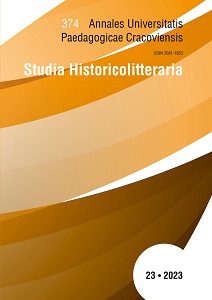„Córa Sienkiewicza”. Złota wolność Zofii Kossak. Historia i współczesność
“Córa Sienkiewicza” (Sienkiewicz’s daughter). Złota Wolność by Zofia Kossak. History and modern times
Author(s): Tadeusz BujnickiSubject(s): Studies of Literature, Modern Age, Polish Literature, 17th Century
Published by: Wydawnictwo Uniwersytetu Komisji Edukacji Narodowej w Krakowie
Keywords: Zofia Kossak-Szczucka; historical novel; reform; „Czas”; Józef Piłsudski; the Arians;
Summary/Abstract: A historical novel Złota wolność by Zofia Kossak Szczucka, connects the beginning of the 17th century with modern times. It was written right after the May Coup and became an argument in political ideological polemics. However, it did not lose the character of a proper historical novel, but when it is read against the background of the journalism of those days, it acquires the characteristics of a great comparison of the two eras. The author of the article conducted a comparative analysis of a novel and journalism of a conservative journal „Czas”, in which Zofia Kossak published her novel. Historical politics practiced in the journal by distinguished journalists, references to historical School of Krakow and its generalizations, make it possible to recreate the ideological concept of a novel: respect for the rule of “the strong hand”, opposition to anarchy and the spirit of “rebellion”, reluctance towards “sejmocracy” and “party favouritism”. The author emphasizes the role of great leaders: Stanisław Zółkiewski and Karol Chodkiewicz, as well as an “ideologist” of changes, a Jesuit Piotr Skarga. The choice of this person enhances the meaning of Catholic axiology. As for the two hetmans, one can notice allusive references to Józef Piłsudski. A separate part in the novel is dedicated to the history of the Arian movement, shown at the moment of its disintegration and internal quarrels. Zofia Kossak presents the history of the Arians as an analogy to party fights in the 1920s. The main characters of the novel, i.e. “Christians”– the Pielszów Brothers – are located in the middle of the most important historical events of the era: in the Zebrzydowski’s rebellion and wars – the Livonian War and the Moscow War – under the leadership of both hetmans. Kossak’s novel can be interpreted in a broad con text as a historically motivated warning against the disintegration of an independent country, involved in political fights between parties. According to the author, in order to rescue both the past and the present, authority should be strengthened and social reforms ought to be introduced. The shape of rules can be determined by a strong and authoritarian individual, but supported by national, religiously motivated unity.
Journal: Annales Universitatis Paedagogicae Cracoviensis. Studia Historicolitteraria
- Issue Year: 2023
- Issue No: 23
- Page Range: 139-163
- Page Count: 25
- Language: Polish

